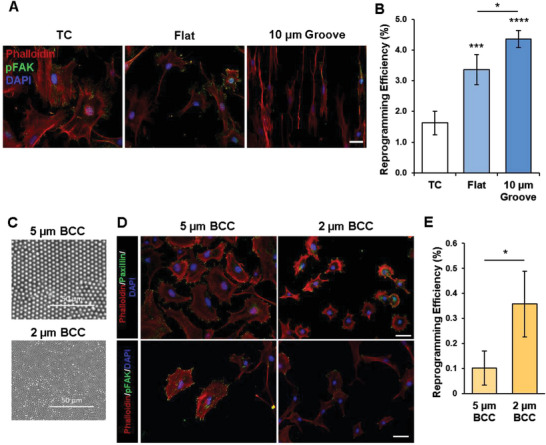Figure 8.

Reduction in cell adhesions using biomaterials promotes iN reprogramming. A) Immunofluorescent staining of actin network (phalloidin), phospho‐FAK, and nuclei (DAPI) in non‐transduced fibroblasts cultured in tissue culture‐treated wells (TC), flat PDMS membranes (Flat), and PDMS membranes with 10‐µm microgrooves. Scale bar, 50 µm. B) Reprogramming efficiency of BAM‐transduced fibroblasts cultured in tissue culture‐treated wells (TC), flat PDMS membranes (Flat), and PDMS membranes with 10 µm grooves at day 14 (n = 4). Significance was determined by a one‐way ANOVA and Tukey's multiple comparison test. C) Scanning electron microscopy images of 5 µm and 2 µm binary colloidal crystals (BCC). D) Immunofluorescent staining of actin network (phalloidin), paxillin, and nuclei (DAPI) (top 2 panels) or actin network (phalloidin), phospho‐FAK, and nuclei (DAPI) (bottom 2 panels) in non‐transduced fibroblasts cultured on 5 µm and 2 µm BCCs for 24 h. Scale bar, 50 µm. E) Reprogramming efficiency of BAM‐transduced fibroblasts cultured on 5 µm and 2 µm BCCs at day 14 (n = 3). Significance determined by two‐tailed, unpaired t‐test. Bar graphs show mean ± standard deviation (*p < 0.05, ***p < 0.001, ****p < 0.0001).
